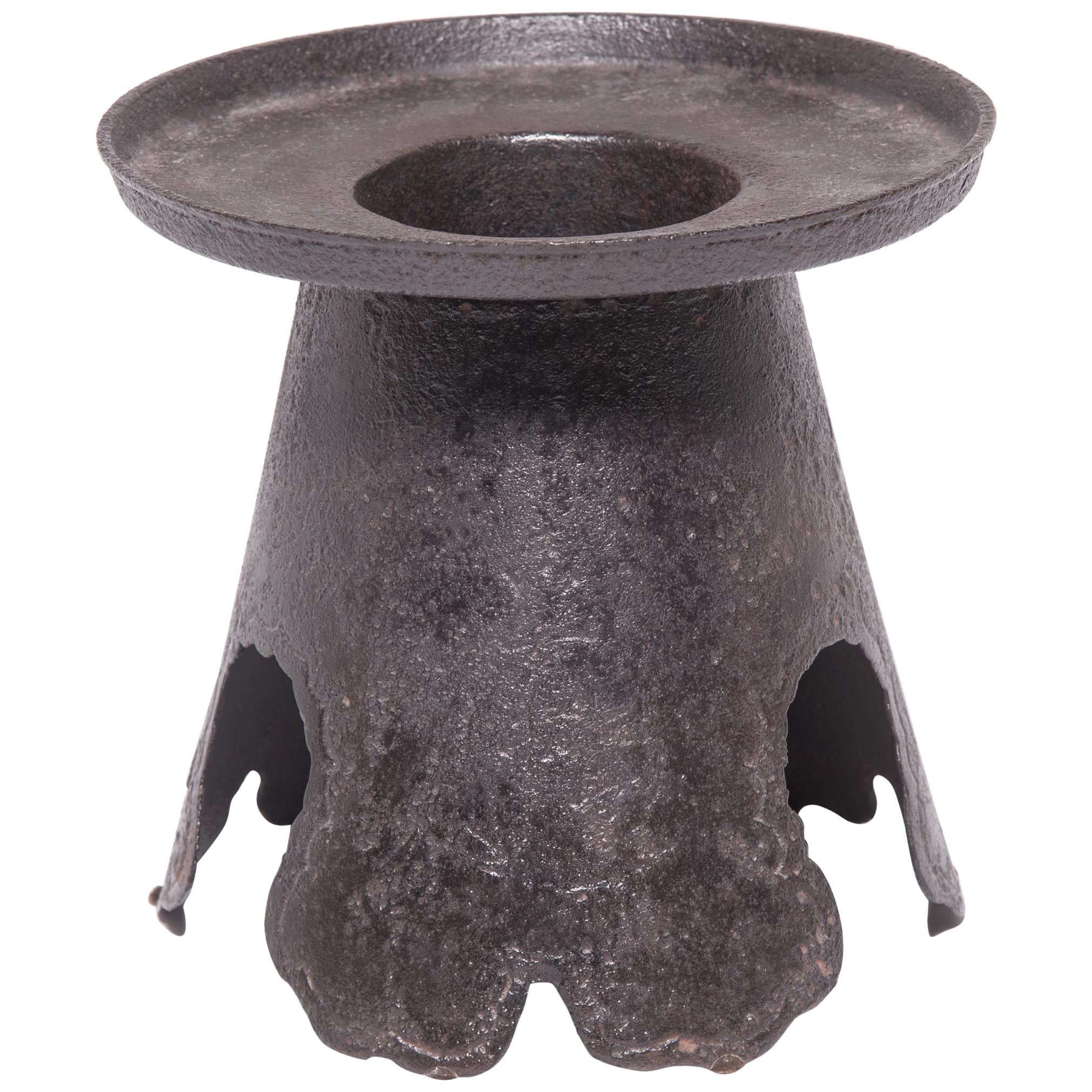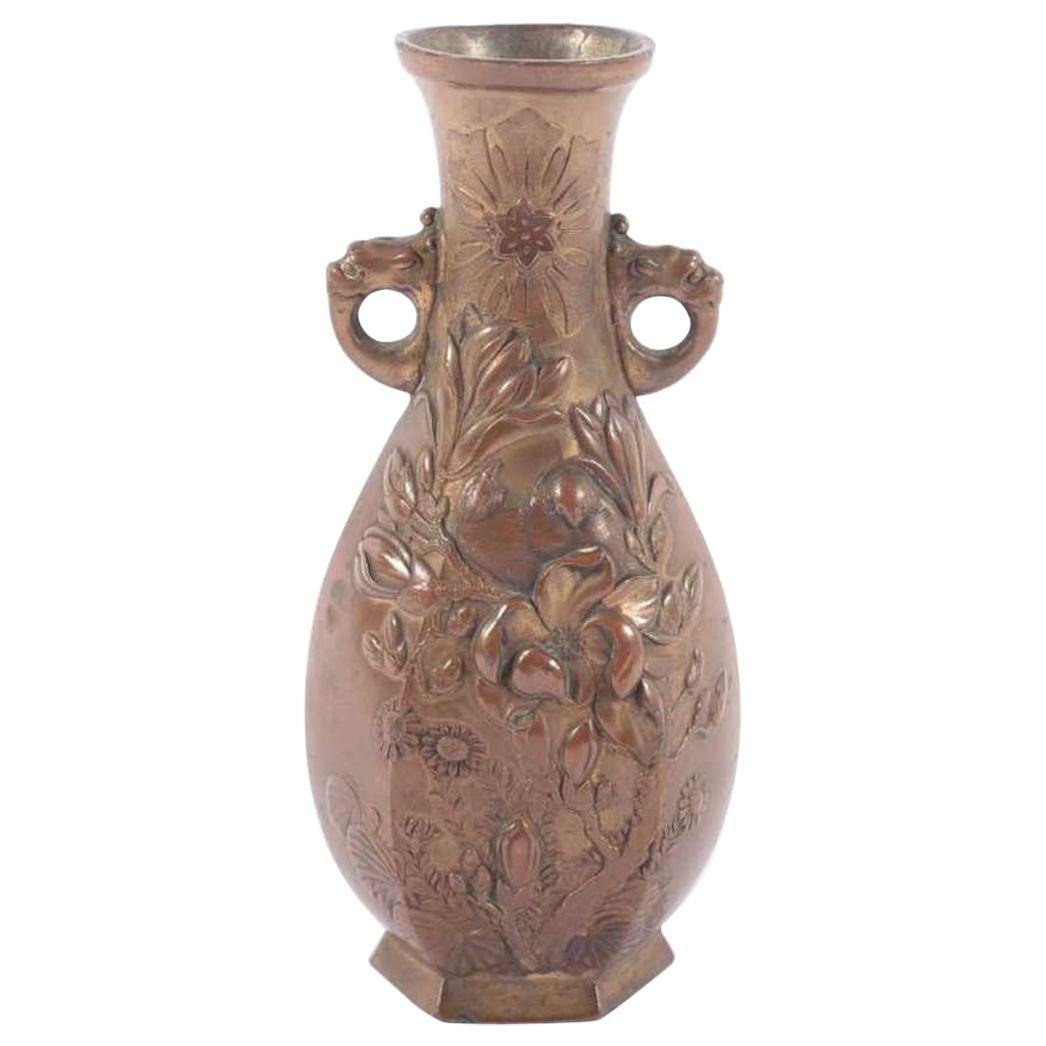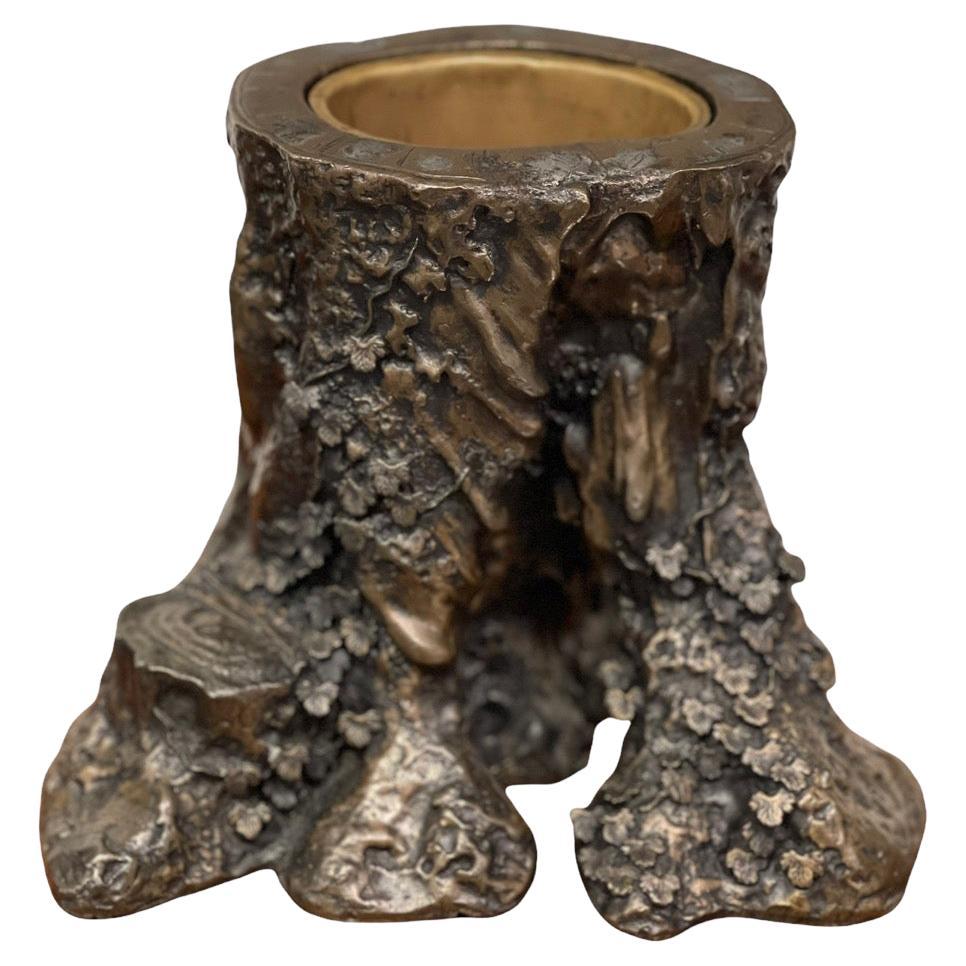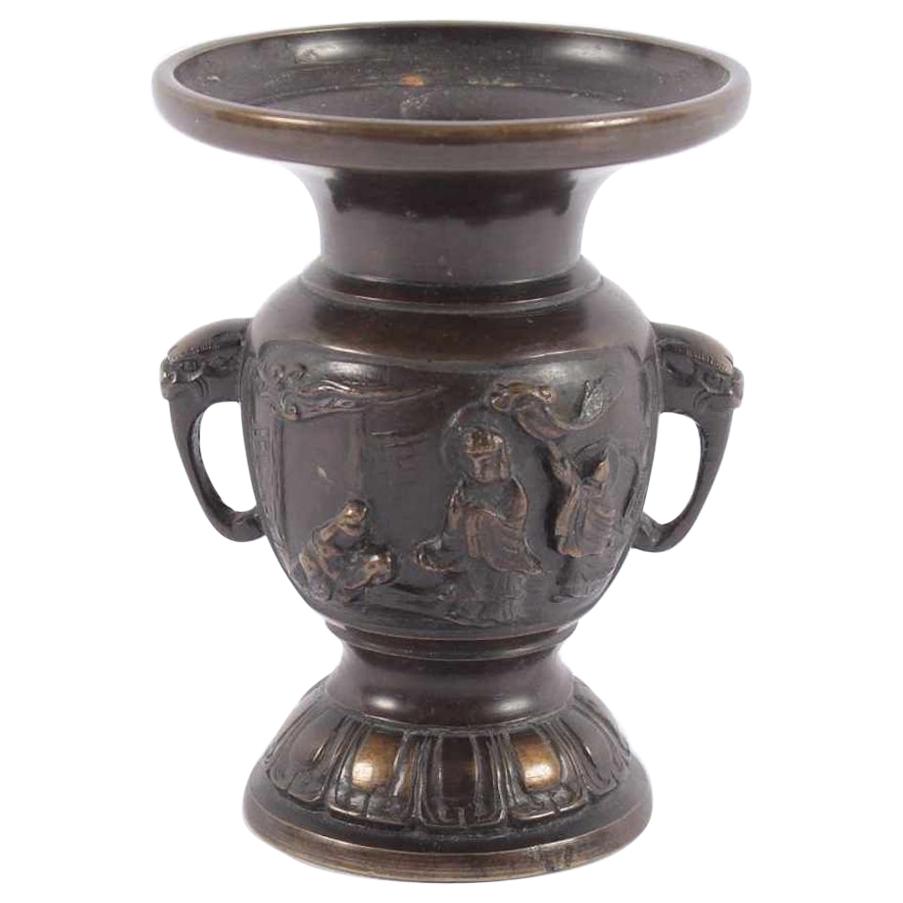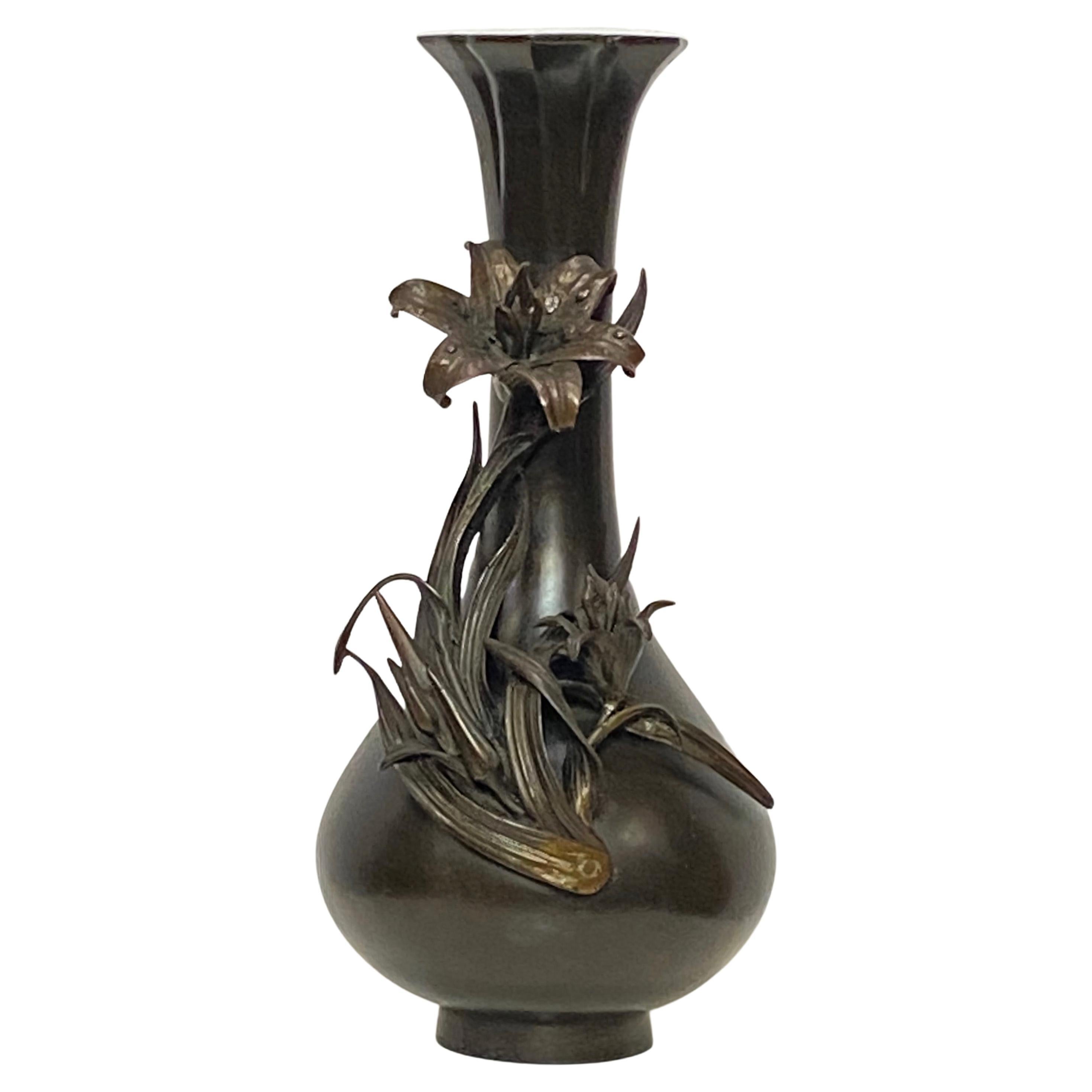Items Similar to Late 19th Century Japanese Meiji Bronze Usubata with Turtles for Ikebana
Want more images or videos?
Request additional images or videos from the seller
1 of 9
Late 19th Century Japanese Meiji Bronze Usubata with Turtles for Ikebana
About the Item
Beautiful two-piece Japanese bronze usubata, a vessel for ikebana flower arranging, with intricate wave form base, Meiji period, late 19th century, Japan. The usubata vessel has four charming turtles and sets on a separately cast base designed as crashing waves. The power of the waves is captured by the numerous exuberant sprays, all rendered masterfully in bronze. The wave-form base with areas of greenish verdigris and minor encrustation around vessel holder ring. The vessel has a warm, chocolate brown patina showing texture from use and handling. The bottom of the vessel has chop/signature.
Condition: Fair: Stem of vessel does not rest perfectly within base. Wear consistent with age and use. Losses to the tips of some of the wave sprays. The wave stand has with some areas of verdigris and encrustation. Please see photos for details.
The usubata is an essential part of ikebana, the Japanese art of flower arranging. More than just a vessel for holding flowers, the usubata forms the foundation of the arrangement, setting the tone of the arrangement, and conveying meaning to the viewer.
- Dimensions:Height: 7 in (17.78 cm)Width: 8 in (20.32 cm)Depth: 7.5 in (19.05 cm)
- Style:Meiji (Of the Period)
- Materials and Techniques:Bronze,Forged
- Place of Origin:
- Period:
- Date of Manufacture:circa 1890
- Condition:Wear consistent with age and use. Minor structural damages. Stem of vessel does not rest perfectly within base. Wear consistent with age and use. Losses to the tips of some of the wave sprays. The wave stand has with some areas of verdigris and encrustation. Please see photos for details.
- Seller Location:Soquel, CA
- Reference Number:
About the Seller
5.0
Platinum Seller
These expertly vetted sellers are 1stDibs' most experienced sellers and are rated highest by our customers.
Established in 1986
1stDibs seller since 2015
166 sales on 1stDibs
Typical response time: <1 hour
- ShippingRetrieving quote...Ships From: Soquel, CA
- Return PolicyA return for this item may be initiated within 14 days of delivery.
More From This SellerView All
- 19th Century Limoges French Painted Porcelain PitcherBy Delinieres & Co. 1Located in Soquel, CA19th Century Limoges French Painted Porcelain Pitcher Rare and prized, American Amateur painting on French Limoges pitcher, circa 1897. Dimensions, 1...Category
Antique 19th Century French Aesthetic Movement Vases
MaterialsPorcelain, Paint
- Japanese Antique Choba Tansu (Merchant Chest) Meiji EraLocated in Soquel, CAJapanese Antique Choba Tansu (Merchant Chest) Meiji Era Antique Choba - Tansu (merchant's chest) from the Tohoku area of Northern Japan circa 1868-1912. Made with Kiri (Paulownia) wo...Category
Antique 1860s Japanese Meiji Furniture
MaterialsWrought Iron
- Camphorwood Campaign Chest - Late 19th Century Chinese Export Case (Medium)Located in Soquel, CACamphorwood Campaign Chest - Late 19th Century Chinese Export Case (Medium) This hardwood chest has brass hardware, including handles. It has a plaque on the top that would have bee...Category
Antique Late 19th Century Chinese Chinese Export Blanket Chests
MaterialsBrass
- Camphorwood Campaign Chest - Late 19th Century Chinese Export R.B. Van Cleve, NYLocated in Soquel, CACamphorwood Campaign Chest - Late 19th Century Chinese Export Case (Medium) This hardwood chest has brass hardware, including handles. It has a brass plaque on the top that has been inscribed with the owner's name, R. B. Van Cleave...Category
Antique Late 19th Century Chinese Chinese Export Blanket Chests
MaterialsBrass
- Vintage Mid-Century Orrefors Crystal Decanter with StopperBy OrreforsLocated in Soquel, CAElegant Mid-Century Modern vintage crystal decanter with stopper by Orrefors (Swedish, founded 1898), c. 1960's. Engraved signature to base Orrefors HM 2498 - this particular style was by Edvard Hall. Includes original red Orrefors Sweden sticker with logo. "Orrefors HM 2498" etched into base. Measures 11.5" H x 3" W x 3" D. Orrefors Glassworks was founded in 1898 on the same site where ironworks operations had been run since 1726. In the same year that the glassworks was founded, a hot shop was built for making technical, medical and household glass and stemware to make use of waste wood and labour. Glass now replaced the less profitable ironworks operations. In 1913, Consul Johan Ekman from Gothenburg became the new owner of Orrefors Glassworks. He appointed Albert Ahlin as manager of the glassworks and this marked the start of a new era. In 1914, Orrefors started manufacturing crystal products, and as well as cut crystal according to purchased patterns and samples, Orrefors made art glass using the overlay technique with etched decoration. The new management quickly saw that artists were needed in the business, so Simon Gate was employed in 1916 and was joined by Edward Hald a year later. That same year, Gate and Hald made their first tentative attempts at figure engraving. They also experimented with the new innovative graal (grail) glass technique that was developed at Orrefors by the master glassblower Knut Bergqvist. The major successes were achieved a few years later at the Gothenburg Exhibition in 1923, and in particular at the Paris Exhibition in 1925. The thin engraved glass was admired by the surrounding world, and both Orrefors and the artists themselves were awarded the Grand Prix. The successes of Simon Gate and Edward Hald in Paris in 1925 constituted the start of the long Orrefors tradition of creative design closely combined with genuine and innovative craftsmanship. Since then, new designers and skilled glassmakers have continued in the spirit of Gate and Hald. Vicke Lindstrand and Edvin Öhrström with the new glass technique called Ariel in the 1930s. Sven Palmqvist with Kraka and Ravenna in the 1940s. And in the 1950s with Fuga, which, along with Nils Landberg’s slender tulip-shaped glass “Tulpan” and Ingeborg Lundin’s apple-shaped vase “Äpplet”, are now seen as symbols of the renaissance of Swedish design. The 1960s are associated with Gunnar Cyrén’s Pop glass, and in the 1970s, Eva Englund, Olle Alberius, Lars Hellsten and Jan Johansson as well as Cyrén worked at the glassworks. Since the 1980s, designers such as Anne Nilsson, Erika Lagerbielke, Helen Krantz, Matz Borgström, Per B Sundberg, Martti Rytkönen, Lena Bergström, Ingegerd Råman, Malin Lindahl and Efva Attling...Category
Mid-20th Century Swedish Mid-Century Modern Bottles
MaterialsCrystal
- Antique 19th Century Silver Tekke Turkmen Carnelian Cuff BraceletLocated in Soquel, CABeautiful Tekke/Turkmen cuff/armlet armlet, known as bilezik, is decorated with four rows of table-cut semi-precious Carnelians. The cuff is for a small boned person (internal diamet...Category
Antique 1850s Turkmen Islamic Collectible Jewelry
MaterialsCarnelian, Gold Plate, Silver
You May Also Like
- Massive Japanese Meiji Period Bronze Vase, Late 19th Century, JapanLocated in Austin, TXA very large Meiji period bronze vase, possibly for temple use, with high relief design and elephant head handles, late 19th century, Japan. Of baluster form and unusual size, yet ...Category
Antique Late 19th Century Japanese Meiji Vases
MaterialsBronze
- Japanese Usubata Ikebana Vessel, c. 1900Located in Chicago, ILThis early 20th century iron vessel is a Meiji-era vase designed especially for ikebana, the Japanese art of floral arrangement. The two-piece vase was cast in the classical usubata ...Category
Early 20th Century Japanese Meiji Vases
MaterialsIron
- Ancient Japanese Meiji Vase, Late 19th CenturyLocated in Roma, ITThis Meiji vase is a beautifully decorated metal alloy vase, realized in Japan under the Meiji Empire (1867-1912). Take a look at the relief decors, lions on the base of the handl...Category
Antique Late 19th Century Japanese Meiji Vases
MaterialsMetal
- 19th Century 'Meiji Period' Japanese Bronze VaseLocated in North Miami, FL19th Century (Meiji Period) Japanese bronze vase. It is realistically cast as a gnarled pine tree trunk with vines growing around it.Category
Antique 19th Century Japanese Meiji Vases
MaterialsBronze
- Ancient Meiji Ceremony Vase, Japan, Late 19th CenturyLocated in Roma, ITThis Meiji ceremony vase is a browned bronze plate vase, realized in Japan under the Meiji Empire (1867-1912). Beautifully decorated with a relied decor representing a Japanese re...Category
Antique Late 19th Century Japanese Meiji Vases
MaterialsMetal
- Large 19th Century Japanese Meiji Period Bronze VaseLocated in San Francisco, CAA large and elegant Meiji period bronze vase with floral decoration and original patina, unsigned. Japan, last quarter of the 19th century.Category
Antique Late 19th Century Japanese Meiji Metalwork
MaterialsBronze
Recently Viewed
View AllMore Ways To Browse
19th Century Meiji Vase
Wave Of Japan
Japanese Bronze Vessel
19th Century Japanese Bronze Vases
Handled Japanese Vase
Japanese Vase With Handles
Antique Chop
Japanes Vase With Handles
Japanese Flower Stand
Antique Japanese Rings
Antique Japanese Ring
Japanes Ikebana
Japanese Ikebana
Ikebana Japan
Ring Handle Vase
Meiji Bronze Vase
Bronze Vase Japanese Meiji
Bronze Vase Japan Meiji

